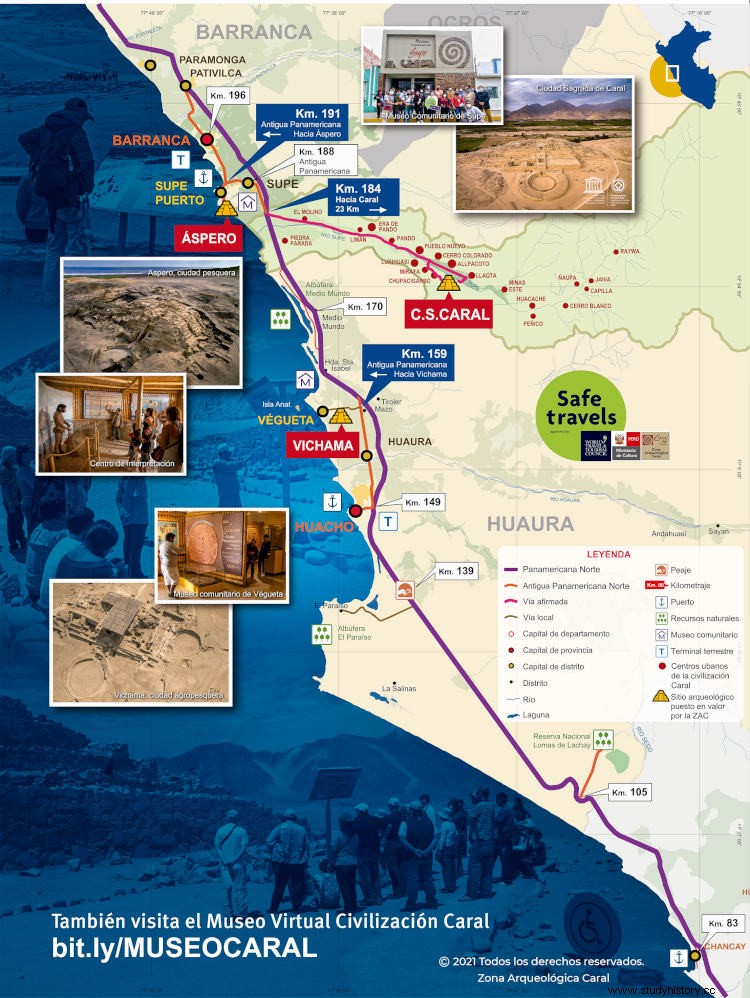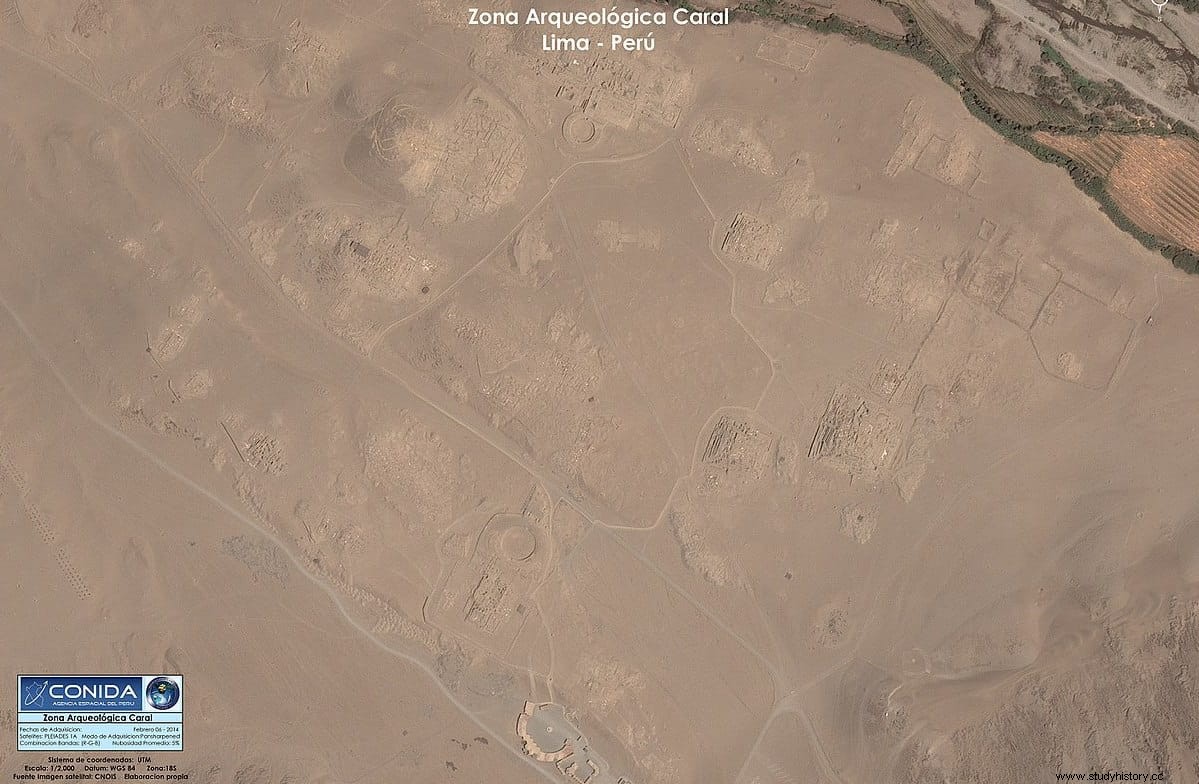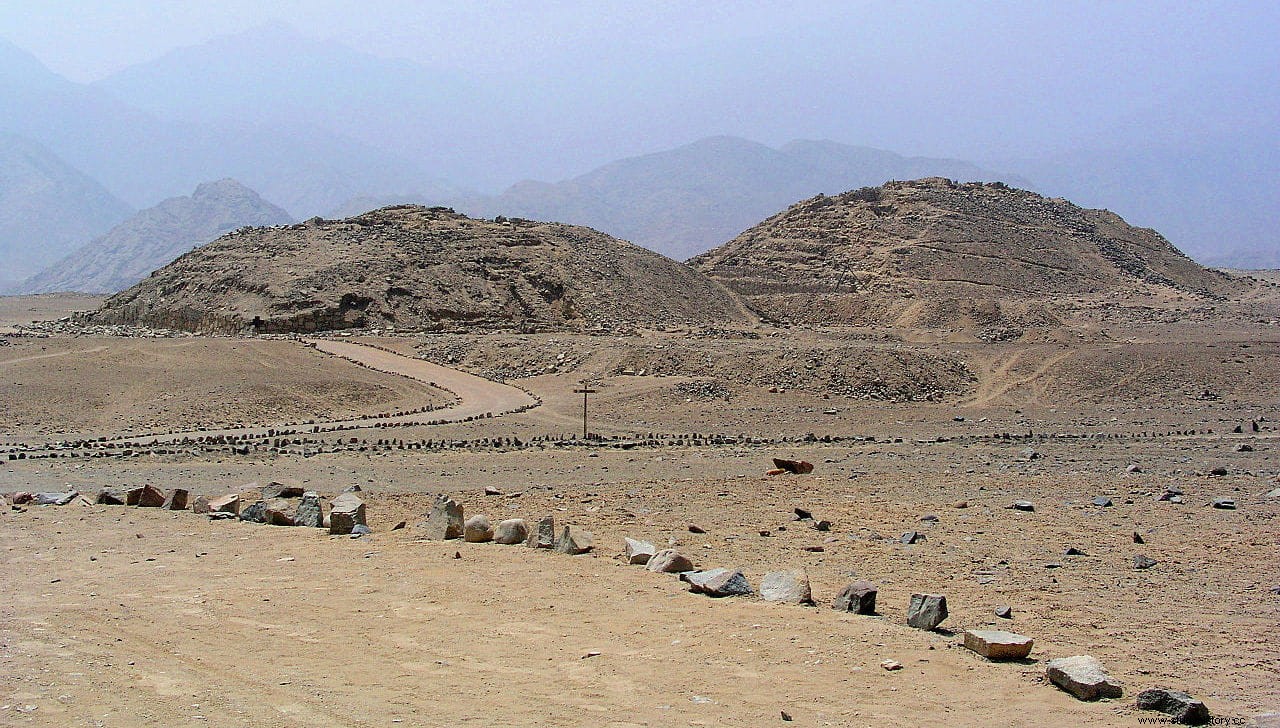If someone is considering making a trip to Peru, it is almost certain that they will have written down places like Machu Picchu, Cuzco, Sacsayhuamán, Lake Titicaca, the Nazca lines, Paracas, Arequipa, the Colca Canyon, the city of of Chan Chan, the Sacred Valley, the Museum of the Lord of Sipán, the huacas of the Sun and the Moon, Lima itself... Incomprehensibly, the place where a civilization was located whose main characteristic is that of having been the oldest of America and creator of the first city of that continent proper:Caral, incorporated into the World Heritage Site in 2009.
A pity because, although it is true that the ruins of its city, Caral-Supe, are not in good condition, it is also true that it is relatively easy to get there, being in the province of Barranca, only one hundred and eighty-four kilometers to the north of Lima.
Much closer, then, than others that do attract preferential attention, such as Nazca or Trujillo, which are much more than twice the distance, and can be reached by the Pan-American highway. And when they arrive, no one will be able to prevent their hair from standing on end when they find themselves surrounded by what remains of that culture, which was contemporary with Ancient Egypt or Sumer, no less.

The Caral civilization developed between 3700 and 1800 BC, between the Late Archaic and Lower Formative Andean periods; It was when the first complex societies arose, with the peculiarity that, in front of the Egyptians and Sumerians (and the Indians and the Chinese), they did so in total isolation. There was no other advanced people in the entire pre-Hispanic American continent (let's emphasize the advanced, since previous settlements have been found, such as those of La Galgada or Huaricoto, among others) with which they could maintain the contacts that usually drive progress. In this sense, it is possible to explain that the other great primitive American civilization, the Mesoamerican Olmec, appeared a millennium and a half later, already during the Preclassic; In the Andean area, the Chavín culture did not emerge around 1200 BC, during the Early Horizon.
Actually, there wasn't a single pachaca (population nucleus) caralino, counting up to eight spread over ten kilometers of the two banks of the Supe Valley:Pueblo Nuevo, Cerro Colorado, Alpacoto, Llapta, Lurihuasi, Miraya, Chupacigarro and Caral itself.
To these should be added a dozen more smaller settlements that would extend the domain area to the coastal valleys, the Huaylas and Conchucos mountain ranges, the Junín plateau and even the basins of tributary rivers of the Amazon, such as the Marañón, the Huallaga and the Ucayali. In total, about four hundred square kilometers.

Therefore, it is possible to imagine the sensation caused by the confirmation that that archaeological site located in Chupacigarro Grande, whose existence had already been revealed in 1965 by the anthropologist Paul Kosok and the archaeologist Richard Schaedel -both Americans-, although without determining its age, corresponded to a preceramic stage. It was the Peruvian Ruth Shady who, based on the work of some predecessors (her compatriot Carlos Williams between 1975 and 1983, the Swiss Frederic Engel from 1979 to 1987), confirmed in 1997 that the inhabitants of the place did not use ceramics and, therefore, Caral must have dated before the other recorded cultures.
Despite the skepticism that it generated, a continuation of that of his predecessor colleagues, the carbon 14 analysis of a hundred and a half pieces, found in the excavations that Shady directed in successive campaigns, confirmed that antiquity:no less than five thousand years that broke the schemes hitherto accepted and established a new civilization in the historical record. The Caralinos constituted a network of settlements that went from the coast to the mountains, with the homonymous city as the administrative and sacred epicenter, and an economy based on agriculture -with improvement of species through experimentation and irrigation canals-, fishing -which included the hunting of cetaceans and supplied the interior settlements- and trade -which was based on barter but would be unequal, since the cities were distinguished by their category -.

All this supported by a political organization whose head was the Hun or lord of the valley, helped by the curacas (local chieftains) and a caste of rulers, priests and officials who directed a society articulated in ayllus (clans), which collaborated with the administration following a hierarchical criterion, in addition to contributing tributes. In that there were no differences with other groups in the environment. The construction of stepped pyramidal temples of adobe and stone, plastered with paint and secured against earthquakes at their foundations by shicras (bags filled with stones), indicates the importance of religion as an element of cohesion and control, presumably through a massive ceremonial system that, as we shall see, included the practice of human sacrifices.
Its advanced architecture evidences extensive mathematical and astronomical knowledge -there were observatories and they had a calendar-; they developed a sculptural art in unfired clay (as we saw, they did not use ceramics and that is because they did not need it, by making stone containers or using empty gourds) and musical art (dozens of cane and bone instruments have been found, such as flutes and bugles), to which we should add a script based on the quipu , since one has been found and representations in relief of others that reveal a much earlier use, then, to that of the Incas.

The capital center of that civilization was the city of Caral, whose oldest strata date back to 5000 BC, although urban development proper began two thousand years later. As usual, it went through various stages until reaching its splendor between 2600 and 2200 BC, after which it began a decline coinciding with the growth of other more powerful centers (for example, Era de Pando, a locality that surpassed it in size), until the progressive abandonment culminated in 1800 B.C. The specific reasons for this decline are unknown, although war seems out of the question because not only have no weapons been discovered at the archaeological site, but there is also no trace of warfare or armies.
What would then be the reasons for the end? Presumably, the usual ones:seismic instability and El Niño, that is, natural phenomena that, as would happen with other American civilizations, would have destroyed their crops. That would collapse the economy, by unbalancing the exchange networks between the coastal populations, which provided fish and shellfish, and the interior, deprived of their agricultural products and, therefore, doomed to poverty and hunger. In such circumstances, the measure that is usually imposed is emigration.

Now, strictly speaking, the march of the Caralinos did not mean the end of their culture, since they settled in valleys not far away where they built new cities; This is the case of Sechín, La Galgada, Huaricoto and Kotosh, which in a certain way kept the original flame alive. On the other hand, the civilization that housed what is considered the first city in America would set the model for later ones, such as the Chavín, the Huari or the Cuzco Quechua, hence everything tends to be interpreted as a kind of cultural continuity.
Caral, we said, began to be systematically excavated in 1996 through the Caral-Supe Archaeological Project directed by the aforementioned Ruth Shady (in 2003 it would be expanded as the Caral-Supe Special Archaeological Project). The result is the emergence of an area of sixty-six hectares divided into two parts. One, the central one, houses thirty-two public buildings, arranged following an astral calendar and in which each building corresponds to a deity; These include seven pyramids, four squares and a couple of different residential complexes (including workshops), one for officials and the other for servants, to all of which must be added some smaller complexes. The other, peripheral, are housing neighborhoods adapted to the topography of the land, possibly from the lowest social stratum, given their modesty.

Obviously, the pyramids are the most colorful elements. Formed by several superimposed platforms and equipped with a central staircase, the one considered main, due to its size and location in the center, measures one hundred and fifty meters long by one hundred and ten wide and twenty-eight meters high; It receives the name of the Greater Pyramid and is associated with other structures, such as a circular pyramid - today in ruins - and a series of stepped platforms. We do not know what the cult was like, although in this sense, it must be said that no human remains have been found in it, which suggests that this type of ritual was only practiced in specific places.
To do this, the Huaca de los Sacrificios, located in Áspero, a coastal settlement at the mouth of the Supe River, which was a town that maintained a close relationship with Caral, is taken as a model, due to its proximity -twenty-three kilometers-, was in charge of stocking it with fish and shellfish. It is part of the route of archaeological sites of that civilization and it was there where, in the seventies, the first signs of human sacrifice were found, when the ritually buried bodies of an adult and a baby were unearthed in that huaca; in 2005 and 2009 they were joined by two children and a newborn, all with deliberately crushed skulls.
Also in Áspero, but in another building, the Huaca de los Ídolos, the skeleton of the baptized Lady of the Four Tupus was exhumed in 2016, a woman of high social status judging by her grave goods. It seems likely that little by little more surprises will emerge about what we already know was the first American civilization.
